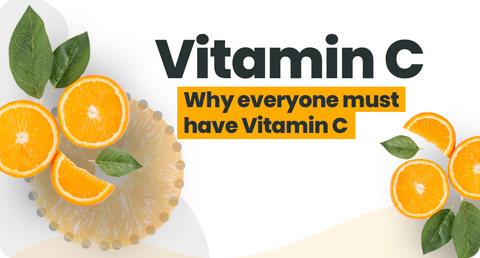Vitamin C, also called ascorbic acid, is a vital nutrient for the body as it is a powerful antioxidant that protects the body’s cells from damage by free radicals, is crucial for the body’s healing process, and helps the body in various important functions like boosting immunity, maintaining skin health, reducing inflammation and the risk of chronic diseases. Just like all other vitamins, our body doesn’t produce Vitamin C, hence we should take it through our diet or supplements. Check best vitamin c tablets price.
BENEFITS OF VITAMIN C
1. Boosts Immunity: Vitamin C helps encourage the production of white blood cells (known as lymphocytes) and phagocytes, which help protect the body against infection.) It also reduces the severity of allergic reactions. Vitamin C deficiency results in impaired immunity and higher susceptibility to infections.
2. Maintains skin health: Vitamin C is critically necessary for the production of collagen, a protein found in skin, hair, muscles, and tendons that reduces wrinkles and makes our skin look younger and smoother. Collagen production slows as we get older, which can lead to drooping skin. Vitamin C stimulates collagen synthesis and acts as an antioxidant that protects against UV-induced photodamage. Vitamin C has been linked to enhanced skin suppleness, reducing wrinkling, and roughness.
3. Reduces risk of Cancer: Vitamin C helps in the treatment and prevention of cancer as it enhances the immune system, and prevents metastasis by inhibiting the enzymes. It also helps in wound healing in cancer patients after surgery, supporting the effectiveness of chemotherapy. (3)
4. Synthesis of protein: A vital function of Vitamin C is that it aids in muscle synthesis. Many organs and soft tissues are supported by collagen. Hydroxyproline, an amino acid used to make collagen, is only synthesised when vitamin C is available. (1)
5. Reduces risk of Cardiovascular diseases: Recent studies have shown that Vitamin C helps in increasing HDL (good cholesterol), and decreases LDL (bad cholesterol) and triglycerides. Vitamin C has also been proven to boost endothelial nitric oxide production, which leads to increased vasodilation and lower blood pressure.
6. Enhances Iron Absorption: Iron is a vital nutrient that serves several purposes in the body. It's required for the production of red blood cells and the transportation of oxygen throughout the body. Taking Vitamin C along with iron help in better absorption. Vitamin C aids in the conversion of iron that is difficult to absorb into a form that is simpler to absorb. Hence it may aid in the prevention of anaemia in persons who are iron deficient.
7. Reduces Inflammation: Several epidemiological studies have examined whether dietary intake, supplemental intake, or serum levels of vitamin C are associated with various cardiovascular diseases and gout. Results of many of these studies have indicated that Vitamin C may help protect against coronary heart disease and gout — diseases with inflammatory components. Additionally, low plasma and leukocyte concentrations of vitamin C have been observed in patients with sepsis — a clinical syndrome characterised by whole-body inflammation that can lead to organ failure.
Sources of Vitamin C
As Vitamin C cannot be stored in the body, it has to be consumed daily from different sources. A wide range of fruits and vegetables contain vitamin C.
- FRUITS -
- Indian gooseberry- 252 mg
- Guava ( Pink flesh)- 222mg
- Manila Tamarind- 55.78 mg
- Strawberry- 50.20 mg
- Mango- 49.09 mg
- Lime juice - 48.16 mg
- Papaya - 43.09 mg
- Orange - 42.72 mg
- VEGETABLES -
- Parsley - 133 mg
- Capsicum- 127 mg
- Drumstick leaves- 108 mg
- Chillies- 94.07 mg
- Brussels sprouts- 89.45 mg
- Amaranth leaves (red) - 86.20 mg
- Cauliflower- 47.14 mg
- Bitter gourd- 46.53 mg
- Peas- 38.40 mg (9)
RDA(Recommended Dietary Intake) /RNI (Recommended Nutrient Intake)
It refers to the daily dietary nutrient intake level that is sufficient to meet the nutritional requirements of nearly all (97 to 98 percent) healthy individuals Ina particular life stage and gender group. (9)
|
Age Group |
Category of work |
Body weight (kg) |
Vitamin C (mg/day) |
|
MEN |
Sedentary |
65 |
80 |
|
Moderate |
|||
|
Heavy |
|||
|
WOMEN |
Sedentary |
55 |
65 |
|
Moderate |
|||
|
Heavy |
|||
|
Pregnant Women |
55+10 |
80 |
|
|
Lactation (0-6 months) |
- |
115 |
|
|
|
Lactation (7-12months) |
||
|
INFANTS |
0-6 months |
5.8 |
20 |
|
6-12 months |
8.5 |
30 |
|
|
CHILDREN |
1-3 y |
12.9 |
30 |
|
4-6 y |
18.3 |
35 |
|
|
7-9 y |
25.3 |
45 |
|
|
BOYS |
10-12 y |
34.9 |
55 |
|
13-15 y |
50.5 |
70 |
|
|
16-18 y |
64.4 |
85 |
|
|
GIRLS |
10-12 y |
36.4 |
50 |
|
13-15 y |
49.6 |
65 |
|
|
16-18 y |
55.7 |
70 |
Because smokers are subjected to increased oxidative stress from the radicals in cigarette smoke and have lower blood concentrations of vitamin C, the recommended consumption for smokers is 35 mg/day more than for nonsmokers.(10)
Deficiency
Scurvy, a potentially lethal condition caused by severe vitamin C deficiency, has been known for ages.(6) Subcutaneous bleeding, poor wound closure, bruising easily, hair and tooth loss, and joint discomfort and swelling are all symptoms of scurvy. In affluent countries, scurvy is uncommon because it may be prevented with as little as 10 milligrammes of vitamin C each day. (10)
SOURCES-
1. https://www.researchgate.net//
2. https://www.ncbi.nlm.nih.gov/
3. https://www.researchgate.net/
4. https://www.ncbi.nlm.nih.gov/
5. https://pubmed.ncbi.nlm.nih.gov/
6. https://www.researchgate.ne/
(Human based study)
(Human based study)
8. https://www.ncbi.nlm.nih.gov/
(All RDA’S and calculations are done according to NIN (ICMR) RDA 2020)
10. https://pubmed.ncbi.nlm.nih.gov/
11. https://pubmed.ncbi.nlm.nih.gov/
12. https://pubmed.ncbi.nlm.nih.gov/
14. https://lpi.oregonstate.edu/
15. https://pubmed.ncbi.nlm.nih.gov/


